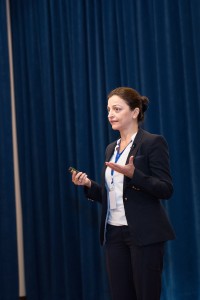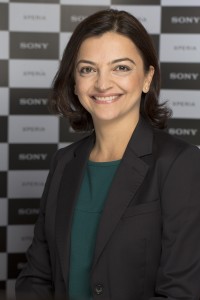A story about the way mobility could increase our attention (while decreasing our attention span), could accelerate our learning behavior and could shape our personalities for better. Could.
THE AQUARIUM OF OUR ATTENTION
On the stage of the Global Youth Forum in Dubai, Gita expresses honesty with a pinch of mentorship towards the audience of tens and tens of young people dreaming of becoming entrepreneurs.
Our technologies have drastically decreased our attention span to a level lower than that of a goldfish.
But this is where mobility comes into place, she explains. While it could be one of the causes, it can also be the cure and, ultimately, the generator of a totally new behavior among the current and upcoming generations.
A few weeks later, as her words were still creating a tidal effect in my mind, I had the chance to meet her at the Sony Mobile office in Dubai and discover more on her views about the connection between mobility and youth.
You know, the theory of the attention span is especially true when we talk about education and young people’s habits. There are so many schools of thought saying that 70% of learning happens in informal contexts nowadays. 10% is represented by formal education, 20% is guided learning and 70% is practice, facilitated or enhanced by various methods, tools and technologies.
Gita pauses a little bit. As the communications manager at Sony Mobile for the MEA region dealing with emerging young consumers changing their usage behaviors at a faster and faster pace, she sees the big picture of capturing or losing their attention. She makes the switch quickly to go at the granular level:
But it depends on the individual how he uses the technology available to focus and what to focus on. Mobile devices offer young people the possibility to access information everywhere and it is their chance to seek knowledge.
She knows that students tend not to / cannot pay attention during the class anymore but this is not necessarily due to the fact that they can learn anywhere and anytime outside the classroom. With the rise of digital technologies, she feels that they don’t feel that they have to learn anymore as everything is searchable on the web. They don’t feel the need to understand the subject. Their learning habits haven’t only changed; they are being replaced by searching habits.
The abundance of information available on the web makes students sluggish at learning. It is the luxury of having plenty of resources. But learning depends on the seeker.
FOR MOBILITY, MOBILITY FOR?
Gita shifts the perspective once more to analyze the mobile industry. She explains that brands in the mobile world are focused on expanding the concepts of accessibility and flexibility while not limiting themselves on specific purposes such as entertainment or learning.
TAGLINE FROM THE FUTURE: Your device is challenging you to be better, to search (for) more, to learn more, to be better.
She doesn’t expect the tagline for new technologies to transform in such a way anytime soon but she hopes that communication on mobile devices will focus more and more on their purpose in life.
We have everything: we have an exponential growth in knowledge and in the power of our devices – we just have to bridge the gap and communicate on how devices can be used to process, organize and deliver knowledge in a more and more efficient way.
She refers to a Pearson study from 2010 where teachers in the US were asked whether they would like to use mobile devices for education. The result? 99% of them said yes. How? It all depends on the seeker. The devices can be even used to replace basic math or reading skills. But Gita believes that we must learn basic skills by ourselves. Then and only then we will be able to use mobile devices for the right purpose – accelerate our learning.
BLENDING TECHNOLOGY, LEARNING AND LIFE
And she speaks from experience as for the last two years she has been teaching marketing at the Wollongong University in Dubai. She had to use various formats of information to attract the students’ attention. Her students moved from the classical handbook that they might read just because of the exams to online videos, case studies or practices.
In order to accelerate their learning, I used my own professional experience, offering them examples related to the day to day life, relating the subject to the brand. The examples were so interesting for them that I had students challenging information, concepts, patterns, it became exciting for them. They were learning by directly looking at a career path and at an industry like in a live TV show. I have always had the fullest class.
She immediately highlights another layer of this type of combined learning – from digital resources to real-life examples:
If one wants to master a subject, he has to go out of his field and learn in a practical manner. Either one plans to become a doctor or an engineer or a marketer, he must understand how the businesses in his industry work. There are so many good ideas that get lost because young people nowadays do not know how to write business plans or to present their ideas.
This in-depth way of thinking about learning stems from her own belief that it is easy to label and understand what learning is when it comes to institutions, courses or trainings. But she believes that a major proportion of what one learns as he grows and comes through informal experiences that can happen in schools as well as in the work environment.
THE LEARNING PATH
After more than 15 years in the marketing industry, she looks back in retrospective and she sees every moment as a learning moment from which she earned knowledge. By practice, she understood are not learning only if they are taught. By practice, she gained the capacity to judge the value of upcoming experiences. And by practice, she learned as much from failures as well as from successes.
You know, companies don’t invest enough in measuring and analyzing successes, the different elements that might have triggered success at different moments in time. When it comes to failures, there are so many things to be reported, communicated and analyzed, that learning is bound to happen. But I always look back on my successes, too and try to understand if I can replicate the learning path.
And she is still learning. This is because she is still studying. This attitude comes from the fact that she considers marketing to be a field where knowledge gets upgraded faster than in other fields.
Information becomes obsolete very fast. What you knew when you graduated or 5 or even 2 years ago might be completely different from the practices of today. One has to study continuously and this may mean reading the latest book in one’s field or attending a course where you can meet great people with great life examples.
Having done a leadership course from the Washington University in 2014, she recalls that she learned as much from the course itself as from the people in the program.
She stops one moment to quote Galilei – I have never met a man so ignorant that I couldn’t learn something from him. – but then she sums it up as brilliantly as the astronomer: People are like walking books – you just have to listen and absorb the knowledge.
Whether or not young people will be able to replicate this attitude, it seems that it is not technology’s role. Gita considers that from the PC to all the portable devices, technology was not intended to trigger a psychological revolution but fulfill as best as possible the role of offering access to information.
As Sony Mobile is promoting the concept of being always digital especially amongst young people and youth communities, Gita explains that research studies at a global level and in UAE and Saudi Arabia show a tendency of young people to use technology to better understand the world as they use connected devices to search and assimilate contextual information.
Towards the end of her talk on the stage of the Global Youth Forum, she is touching on this tricky aspect of the seeker’s responsibility. As she tells the young people in the audience that devices offer them the flexibility and the functionality to seek, she also stresses the idea that it is their chance to access information and then seek for knowledge.







